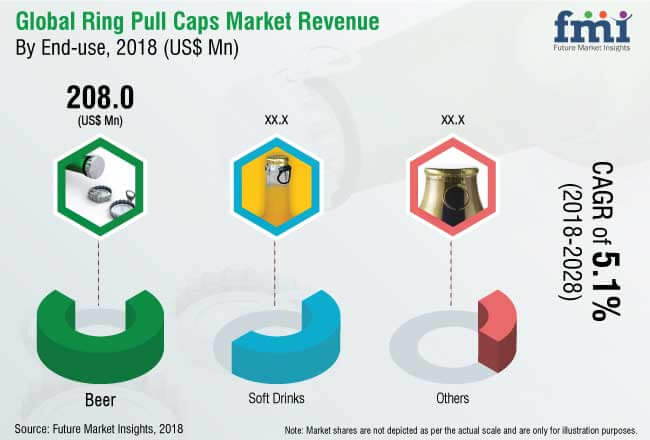Increasing demand for aseptic packaging in the pharmaceutical industry is projected to be a critical factor driving the sales of blow-fill-seal equipment-required for packaging forms including vials, bottles, prefilled syringes, and ampoules. Moreover, unique ability of blow-fill-seal equipment to pack formulated drugs in clean and contamination free environment, without any human interface, thereby increasing the product safety, is also projected to increase the demand for blow-fill-seal equipment, during the assessment period 2018-2028. Other than liquid filled containers, packaging of different types of ointments, gels, and food products including soft drinks and milk products, is also expected to influence the global blow-fill-seal equipment market. However, the pharmaceutical industry is evaluated to hold a lion’s share to the tune of nearly 90% of the global blow-fill-seal equipment market.
As per a recently released market analysis by Future Market Insights, the global blow-fill-seal equipment market is anticipated to expand at a high CAGR of 5.9% and reach a valuation of US$ 7,692. 9 Mn, poised to grow by an impressive 2.2X by the end of the forecast period.
Request a Sample Report with Table of Contents and Figures: https://www.futuremarketinsights.com/reports/sample/rep-gb-7388
Ever since the inception of blow-fill-seal equipment, the technology has remained a sustainable process for packaging biological products, considering its aseptic nature and high automations and low production errors. Moreover, increasing pharmaceutical demands for efficient drug packaging through smaller batch size production, efficient time-to-market, and less API waste would also drive the blow-fill-seal equipment market.
Given the risks associated with glass vials and syringes, plastic for blow-fill-seal equipment is evaluated to dominate the global blow-fill-seal equipment market. Chances of either glass fragments entering the patient’s body or glass packaging breaking during production or transportation are some key factors complementing the demand for plastic containers made though blow-fill-seal technologies. To address packaging limitations including delamination (flaking) and breakage, the pharmaceutical industry is also moving towards alternative packaging formats like polymer containers, enabling a broad array of designs similar to blow-fill-seal packaging. Additionally, universal acceptance of blow-fill-seal equipment and technologies by various global authorities including FDA, EMEA, and USP will further boost the growth of global blow-fill-seal equipment market.
“The Food and Drug Administration’s (FDA’s) has characterized blow-fill-seal technology as an advanced aseptic processing machine. Government and regulatory bodies’ positive nod to BFS technology in the packaging of liquid products is a critical factor driving the blow-fill-seal equipment market, globally. However, high initial set up cost including operator training, establishing technology-specific quality systems, allocation of validation resources is projected to restrict the sales of blow-fill-seal equipment in the global market”, Lead Analyst, Packaging Industry, Future Market Insights
Preview Analysis Blow-fill-seal Equipment Market Segmented By Production Capacity – Up to 5,000 containers/hr., 5,000-10,000 containers/hr.,Above 10,000 containers/hr.; By Product Type – Bottles, Ampoules, Vials, Prefilled Syringes & Injectable; By End-Use Industry – Pharmaceuticals, Food & Beverage, Cosmetics & Personal Care: https://www.futuremarketinsights.com/reports/blow-fill-seal-equipment-market
FMI predicts further increased adoption of blow-fill-seal equipment in the next five years, considering growing acceptance in the beverages packaging industry for in-house container development and filling. Customized blow-fill-seal equipment are expected to eliminate the need for raw material warehousing along with handling process, especially in cold drink companies looking for efficient and economical in-house BFS packaging facilities. Moreover, enhanced sealing and leak proofing offered by blow-fill-seal equipment is projected to drive the market, as it would further reduce the material and time consumption during secondary packaging in pharmaceutical and F&B industries. Given to the growing demand of blow-fill-seal equipment for clean packaging, manufacturers are developing highly efficient with high output capacity. Increased research and development activities among manufacturers to step up the innovations in the global blow-fill-seal equipment market will further drive up the adoption.
The global blow-fill-seal equipment market is a monopoly to Rommelag, holding close to 90% of the total market share. However, tier-3 manufactures including Brevetti Angela S.R.L., Serac Inc. and SIPA S.p.A are expected to contribute majority of revenue share in the global blow-fill-seal equipment market. In terms of forward market strategies, New Product Development (NPD) and strategic collaborations would be the way ahead for many top players in the global blow-fill-seal market. For more insights on the competitive landscape of the global blow-fill-seal market, connect with the expert analysts of Future Market Insights at press@futuremarketinsights.com
Our advisory services are aimed at helping you with specific, customised insights that are relevant to your specific challenges. Let us know about your challenges and our trusted advisors will connect with you: https://www.futuremarketinsights.com/askus/rep-gb-7388
More from Packaging Market Intelligence:
- Medical Device Packaging Market Segmented By Packaging type -Bags & Pouches, Containers, Trays, Stick Packs, Clamshell Blister Packs, Boxes; By Material Type – PE, HDPE, LDPE, LLDPE, PET, PP, PS, PVC, Aluminium, Glass, Paper Laminates, Fabric; By Application – Disposable Consumables, Monitoring & Diagnostic Equipment, Therapeutic Equipment; By End User – Medical Manufacturing, Contract Packaging, Others: https://www.futuremarketinsights.com/reports/medical-device-packaging-market
- Glue Machine Market Segmented By product type – PVA glue, hide glue, EPOXY, cyanoacrylate glue, polyurethane glue; By machinery type – hot melt machinery, adhesives, and cold glue equipment; By end use type – food & beverage industry, health care industry, industrial goods, automotive industry, household products, electronics industry and other manufacturing industry: https://www.futuremarketinsights.com/reports/glue-machine-market
- Flat Valve Caps And Closures Market Segmented By material Type – plastic (Polypropylene, Polyethylene, Polystyrene), metal (aluminum and steel), glass, wood, rubber and elastomers, and paperboard; By application type – beverage, food, cosmetic and personal care products, pharmaceutical, industrial chemicals & automotive: https://www.futuremarketinsights.com/reports/flat-valve-caps-and-closures-market
